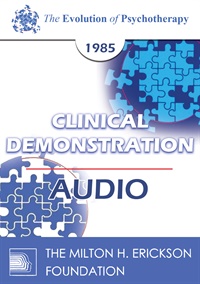
- Average Rating:
- Not yet rated
- Topic Areas:
- Conversation Hours | Psychotherapy
- Categories:
- Evolution of Psychotherapy | Evolution of Psychotherapy 2005
- Faculty:
- James F. Masterson, MD
- Duration:
- 1 Hour
- Format:
- Audio Only
- Original Program Date:
- Dec 10, 2005
- Short Description:
- Conversation Hour 13 from the Evolution of Psychotherapy 2005 - James Masterson, MD
- Price:
- $15.00 - Base Price
Tags: James Masterson Psychotherapy

- Average Rating:
- Not yet rated
- Topic Areas:
- Point/Counterpoint Sessions | Neurobiology | Object Relations Theory | Psychotherapy | Attachment | History of Psychotherapy
- Categories:
- Evolution of Psychotherapy | Evolution of Psychotherapy 2005
- Faculty:
- James F. Masterson, MD | Erving Polster, PhD
- Duration:
- 1 Hour 18 Minutes
- Format:
- Audio Only
- Original Program Date:
- Dec 10, 2005
- Short Description:
- This talk first briefly reviews the history of the Developmental, Self and Object Relations theoretical approach to the personality disorders as a preface to exploring the latest additions to the theory, i.e., Attachment Theory and Neurobiological Development of the Self in the Right Brain. Attachment Theory: The work of Ainsworth and others is described leading to the attachment categories in the infant and the adult. Many follow-up studies are presented validating the persistence of the categories over time. Neurobiologic Development of the Self in the Right Brain: The work of Alan Schore, Ph.D. is used to describe the development of the self in the right prefrontal cortex of the brain. Integration: The integration of the two theories with the object relations approach are described and illustrated through therapeutic alliance
- Price:
- $15.00 - Base Price

- Average Rating:
- Not yet rated
- Topic Areas:
- Topical Panels | Transference / Countertransference | Psychotherapy
- Categories:
- Evolution of Psychotherapy | Evolution of Psychotherapy 2005
- Faculty:
- James Hillman, PhD | Otto Kernberg, MD | James F. Masterson, MD | Michael White, B.A.S.W.
- Duration:
- 1 Hour
- Format:
- Audio Only
- Original Program Date:
- Dec 10, 2005
- Short Description:
- Topical Panel 15 from the Evolution of Psychotherapy 2005 - Transference / Countertransference Featuring James Hillman, PhD; Otto Kernberg, MD; James Masterson, MD; and Michael White, BASW Moderated by Ellyn Bader, PhD
- Price:
- $15.00 - Base Price
- Average Rating:
- Not yet rated
- Topic Areas:
- Workshops | Personality Disorders | Psychoanalysis | Psychotherapy | Therapeutic Relationship | Transference / Countertransference
- Categories:
- Evolution of Psychotherapy | Evolution of Psychotherapy 2005
- Faculty:
- James F. Masterson, MD
- Course Levels:
- Master Degree or Higher in Health-Related Field
- Duration:
- 2:39:20
- Format:
- Audio and Video
- Original Program Date:
- Dec 07, 2005
- Short Description:
- The therapeutic alliance is described along with transference and transference acting-out. The therapeutic task is defined - i.e., to help the patient convert transference acting-out to therapeutic alliance and transference through appropriate interventions. The psychotherapy of each of the disorders (Borderline, Narcissistic and Schizoid) is described in terms of indications, therapeutic technique and goals. Clinical examples will be given. Two videotapes of psychotherapy will be presented- one with a Borderline patient and the other with a Narcissistic disorder. Countertransference problems are described.
- Price:
-
Sale is $29.00
price reduced from Base Price - $59.00

- Average Rating:
- Not yet rated
- Topic Areas:
- Psychotherapy | Invited Addresses | Narcissism | Personality Disorders | Psychoanalysis | Object Relations Theory
- Categories:
- Evolution of Psychotherapy | Evolution of Psychotherapy 2000
- Faculty:
- James F. Masterson, MD | James Hillman, PhD
- Duration:
- 1 Hour 19 Minutes
- Format:
- Audio Only
- Original Program Date:
- May 29, 2000
- Short Description:
- In this paper, Dr. Masterson gives an understanding of the intrapsychic structure of Narcissistic Personality Disorder and how it finds clinical expression through the disorders of the self triad. Clinical cases are presented to illustrate how the therapeutic intervention of mirroring interpretation of narcissistic vulnerability helps the patient to convert transference acting-out to therapeutic alliance and transference, thereby creating the condition for psychoanalytic psychotherapy.
- Price:
- $15.00 - Base Price

- Average Rating:
- Not yet rated
- Topic Areas:
- Topical Panels | Transference / Countertransference | Psychotherapy
- Categories:
- Evolution of Psychotherapy | Evolution of Psychotherapy 2000
- Faculty:
- Otto Kernberg, MD | Judd Marmor | James F. Masterson, MD | Erving Polster, PhD
- Duration:
- 55 Minutes
- Format:
- Audio Only
- Original Program Date:
- May 28, 2000
- Short Description:
- Topical Panel 15 Featuring Otto Kernberg, MD, Judd Marmor, MD, James Masterson, MD, and Erving Polster, PhD. Moderated by Ellyn Bader, PhD.
- Price:
- $15.00 - Base Price

- Average Rating:
- Not yet rated
- Topic Areas:
- Psychotherapy | Dialogues | Personality Disorders
- Categories:
- Evolution of Psychotherapy | Evolution of Psychotherapy 2000
- Faculty:
- Otto Kernberg, MD | James F. Masterson, MD
- Duration:
- 55 Minutes
- Format:
- Audio Only
- Original Program Date:
- May 27, 2000
- Short Description:
- EP00 Dialogue 04 - Personality Disorders - Otto Kernberg, M.D., and James Masterson, M.D. Given a topic, to become aware of the differing approaches to psychotherapy, and to identify the strengths and weaknesses in each approach. Moderated by Michael Yapko, Ph.D.
- Price:
- $15.00 - Base Price

- Average Rating:
- Not yet rated
- Topic Areas:
- Topical Panels | Resistance | Psychotherapy
- Categories:
- Evolution of Psychotherapy | Evolution of Psychotherapy 2000
- Faculty:
- Albert Ellis, PhD | James F. Masterson, MD | Zerka Moreno | Michael White, B.A.S.W.
- Duration:
- 1:02:00
- Format:
- Audio Only
- Original Program Date:
- May 27, 2000
- Short Description:
- Topical Panel 06 from the Evolution of Psychotherapy 2000 - Resistance Featuring Albert Ellis, PhD, James Masterson, MD, Zerka Moreno, and Michael White, BASW. Moderated by Christine Padesky, PhD.
- Price:
- $15.00 - Base Price

- Average Rating:
- Not yet rated
- Topic Areas:
- Workshops | Narcissism | Personality Disorders | Psychoanalysis | Object Relations Theory | Psychotherapy | Supervision
- Categories:
- Evolution of Psychotherapy | Evolution of Psychotherapy 2000
- Faculty:
- James F. Masterson, MD
- Duration:
- 1 Hour 10 Minutes
- Format:
- Audio Only
- Original Program Date:
- May 25, 2000
- Short Description:
- This workshop comprises three elements: A one-hour videotape demonstrating the use of mirroring interpretation of narcissistic vulnerability to establish a therapeutic alliance, discussion of the tape, and supervision of cases presented by the audience.
- Price:
- $15.00 - Base Price

- Average Rating:
- Not yet rated
- Topic Areas:
- Invited Addresses | Object Relations Theory | Intimacy | Psychotherapy
- Categories:
- Evolution of Psychotherapy | Evolution of Psychotherapy 1995 | Pioneers in Couples and Family Therapy
- Faculty:
- James F. Masterson, MD | Cloe Madanes, HDL, LIC
- Duration:
- 1:29:20
- Format:
- Audio Only
- Original Program Date:
- Dec 17, 1995
- Short Description:
- The development and function of the self's capacity for intimacy is described through infancy, childhood and adolescence. The normal process of achieving intimacy is outlined. The illusions of intimacy of Disorders of the Self are then described with detailed clinical presentations of each diagnostic category. The therapeutic interventions necessary to deal with these defenses are then outlined.
- Price:
- $15.00 - Base Price

- Average Rating:
- Not yet rated
- Topic Areas:
- Conversation Hours | Psychotherapy
- Categories:
- Evolution of Psychotherapy | Evolution of Psychotherapy 1995
- Faculty:
- James F. Masterson, MD
- Duration:
- 1 Hour
- Format:
- Audio Only
- Original Program Date:
- Dec 16, 1995
- Short Description:
- Conversation Hour 16 from the Evolution of Psychotherapy 1995 - James Masterson, MD
- Price:
- $15.00 - Base Price
Tags: James Masterson Psychotherapy

- Average Rating:
- Not yet rated
- Topic Areas:
- Dialogues | Psychotherapy
- Categories:
- Evolution of Psychotherapy | Evolution of Psychotherapy 1995
- Faculty:
- Otto Kernberg, MD | James F. Masterson, MD
- Course Levels:
- Master Degree or Higher in Health-Related Field
- Duration:
- 57:15
- Format:
- Audio Only
- Original Program Date:
- Dec 15, 1995
- Short Description:
- Dialogue 04 from the Evolution of Psychotherapy 1995 - Current Controversies in Psychodynamic Therapy, featuring Otto Kernberg, MD; and James Masterson, MD.
- Price:
- $15.00 - Base Price

- Average Rating:
- Not yet rated
- Topic Areas:
- Supervision Panels | Supervision | Psychotherapy
- Categories:
- Evolution of Psychotherapy | Evolution of Psychotherapy 1995
- Faculty:
- James Bugental, PhD | James F. Masterson, MD | Donald Meichenbaum, PhD
- Duration:
- 58 Minutes
- Format:
- Audio Only
- Original Program Date:
- Dec 15, 1995
- Short Description:
- Supervision Panel 1 from the Evolution of Psychotherapy 1995 - Bugental, Masterson and Meichenbaum Educational Objective: To compare and contrast clinical and philosophical perspectives of experts.
- Price:
- $15.00 - Base Price

- Average Rating:
- Not yet rated
- Topic Areas:
- Topical Panels | Psychotherapy | Therapist Development | Training
- Categories:
- Evolution of Psychotherapy | Evolution of Psychotherapy 1995
- Faculty:
- Mary Goulding, MSW | James F. Masterson, MD | Joseph Wolpe, M.D. | Jeffrey Zeig, PhD
- Course Levels:
- Master Degree or Higher in Health-Related Field
- Duration:
- 1:03:57
- Format:
- Audio Only
- Original Program Date:
- Dec 15, 1995
- Short Description:
- A panel of experts discuss their viewpoints on the given topic.
- Price:
- $15.00 - Base Price

- Average Rating:
- Not yet rated
- Topic Areas:
- Workshops | Psychotherapy | Therapist Development
- Categories:
- Evolution of Psychotherapy | Evolution of Psychotherapy 1995
- Faculty:
- James F. Masterson, MD
- Duration:
- 2 Hours 35 Minutes
- Format:
- Audio Only
- Original Program Date:
- Dec 13, 1995
- Short Description:
- The development of the capacities of the healthy real self is described along with the impairments in these capacities that ensue in the Disorders of the Self. A diagnostic system based on the Disorders of the Self is presented, its conceptual basis is explained, and it is compared with DSM IV. A central triadic psychodynamic theme of these disorders, i.e., self-activation leads to depression which leads to defense, is described.
- Price:
- $15.00 - Base Price

- Average Rating:
- Not yet rated
- Topic Areas:
- Invited Addresses | Borderline | Narcissism | Personality Disorders | Attunement | Therapeutic Relationship | Psychotherapy
- Categories:
- Evolution of Psychotherapy | Evolution of Psychotherapy 1990
- Faculty:
- James F. Masterson, MD | Helen Singer Kaplan, MD, PhD
- Duration:
- 1 Hour 29 Minutes
- Format:
- Audio Only
- Original Program Date:
- Dec 16, 1990
- Short Description:
- The importance of therapeutic alliance is described. Therapeutic alliance, transference, and transference acting-out are defined and distinguished from each other and the therapeutic task of helping the patient to convert transference acting-out to therapeutic alliance and transference is outlined. The differences in the form and content of the intrapsychic structure are described to show why different therapeutic techniques are necessary to establish the therapeutic alliance: Confrontation with the borderline and mirroring interpretation of narcissistic vulnerability with the Narcissistic Personality Disorder. A brief case illustrates each.
- Price:
- $15.00 - Base Price

- Average Rating:
- Not yet rated
- Topic Areas:
- Topical Panels | Transference / Countertransference | Therapist Development
- Categories:
- Evolution of Psychotherapy | Evolution of Psychotherapy 1990
- Faculty:
- Alexander Lowen, MD | James F. Masterson, MD | Rollo May, PhD | Erving Polster, PhD
- Duration:
- 1 Hour
- Format:
- Audio Only
- Original Program Date:
- Dec 15, 1990
- Short Description:
- Topical Panel 11 from the Evolution of Psychotherapy 1990 - Transference / Countertransference Featuring Alexander Lowen, MD; James Masterson, MD; Rollo May, PhD; and Erving Polster, PhD. Moderated by Ruth McClendon, MSW.
- Price:
- $15.00 - Base Price

- Average Rating:
- Not yet rated
- Topic Areas:
- Workshops | Borderline | Personality Disorders | Narcissism | Psychotherapy | Supervision
- Categories:
- Evolution of Psychotherapy | Evolution of Psychotherapy 1990
- Faculty:
- James F. Masterson, MD
- Duration:
- 2 Hours 34 Minutes
- Format:
- Audio Only
- Original Program Date:
- Dec 14, 1990
- Short Description:
- This workshop will demonstrate the clinical application of developmental, self, and object relations theory to psychotherapy with borderline and narcissistic patients - both shorter and longer term. After brief orienting remarks by Dr. Masterson, the participants will present their clinical material for discussion. This material can vary from single interactions to vignettes to longer presentations. Particular attention will be paid to the role of therapeutic neutrality and countertransference. This is a repeat offering of Wednesday's workshop.
- Price:
- $15.00 - Base Price

- Average Rating:
- Not yet rated
- Topic Areas:
- Topical Panels | Brief Therapy | Psychotherapy
- Categories:
- Evolution of Psychotherapy | Evolution of Psychotherapy 1990
- Faculty:
- Judd Marmor | James F. Masterson, MD | Donald Meichenbaum, PhD | Mara Selvini Palazzoli, MD
- Duration:
- 58 Minutes
- Format:
- Audio Only
- Original Program Date:
- Dec 13, 1990
- Short Description:
- Topical Panel 04 from the Evolution of Psychotherapy 1990 - Brief Versus Long-Term Therapy Featuring Judd Marmor, MD, PhD; James Masterson, MD; Donald Meichenbaum, PhD; and Mara Selvini Palazzoli, MD. Moderated by Stephen Lankton, MSW.
- Price:
- $15.00 - Base Price

- Average Rating:
- Not yet rated
- Topic Areas:
- Conversation Hours | Psychotherapy
- Categories:
- Evolution of Psychotherapy | Evolution of Psychotherapy 1990
- Faculty:
- James F. Masterson, MD
- Duration:
- 59 Minutes
- Format:
- Audio Only
- Original Program Date:
- Dec 12, 1990
- Short Description:
- Conversation Hour 5 from the Evolution of Psychotherapy 1990, featuring James Masterson, MD.
- Price:
- $15.00 - Base Price
Tags: James Masterson Psychotherapy

- Average Rating:
- Not yet rated
- Topic Areas:
- Supervision Panels | Supervision | Psychotherapy
- Categories:
- Evolution of Psychotherapy | Evolution of Psychotherapy 1990
- Faculty:
- William Glasser, MD | Miriam Polster | James F. Masterson, MD
- Duration:
- 54 Minutes
- Format:
- Audio Only
- Original Program Date:
- Dec 12, 1990
- Short Description:
- Supervision Panel 01 from the Evolution of Psychotherapy 1990 - Featuring Glasser, Polster and Masterson Moderated by W Michael Munion, MA
- Price:
- $15.00 - Base Price
- Average Rating:
- Not yet rated
- Topic Areas:
- Supervision Panels | Psychotherapy | Supervision
- Categories:
- Evolution of Psychotherapy | Evolution of Psychotherapy 1985 | Pioneers in Couples and Family Therapy
- Faculty:
- Murray Bowen, MD | James F. Masterson, MD | Erving Polster, PhD | Carl Whitaker, MD
- Course Levels:
- Master Degree or Higher in Health-Related Field
- Duration:
- 56:24
- Format:
- Audio and Video
- Original Program Date:
- Dec 14, 1985
- Short Description:
- Seasoned clinicians explore the art of supervision: balancing professional development with therapeutic neutrality, managing countertransference, and honoring each therapist's unique talents. A candid dialogue on cultivating curiosity, reducing performance anxiety, and supporting emerging practitioners through experiential learning and strategic mentorship. Moderated by Sharon Cottor, MSW.
- Price:
-
Sale is $29.00
price reduced from Base Price - $59.00
- Average Rating:
- Not yet rated
- Topic Areas:
- Conversation Hours | Psychotherapy
- Categories:
- Evolution of Psychotherapy | Evolution of Psychotherapy 1985
- Faculty:
- James F. Masterson, MD
- Course Levels:
- Master Degree or Higher in Health-Related Field
- Duration:
- 1:00:16
- Format:
- Audio and Video
- Original Program Date:
- Dec 14, 1985
- Short Description:
- Conversation Hour 13 featuring James F Masterson, MD
- Price:
-
Sale is $29.00
price reduced from Base Price - $59.00
Tags: Psychotherapy James Masterson

- Average Rating:
- Not yet rated
- Topic Areas:
- Clinical Presentations | Borderline | Children and Adolescent Therapy | Passive-Aggressiveness | Confrontation | Psychotherapy
- Categories:
- Evolution of Psychotherapy | Evolution of Psychotherapy 1985
- Faculty:
- James F. Masterson, MD
- Duration:
- 59 Minutes
- Format:
- Audio Only
- Original Program Date:
- Dec 13, 1985
- Short Description:
- Educational Objectives: To describe the adolescent passive-aggressive defense (borderline) To know how to use confrontation to deal with passive-aggressive defenses
- Price:
- $15.00 - Base Price
- Average Rating:
- Not yet rated
- Topic Areas:
- Invited Addresses | Object Relations Theory | Psychotherapy
- Categories:
- Evolution of Psychotherapy | Evolution of Psychotherapy 1985 | Pioneers in Couples and Family Therapy
- Faculty:
- James F. Masterson, MD | Jay Haley, MA
- Course Levels:
- Master Degree or Higher in Health-Related Field
- Duration:
- 1:22:04
- Format:
- Audio and Video
- Original Program Date:
- Dec 13, 1985
- Short Description:
- Educational Objectives: To describe the process that integrates the developmental perspective with object relations theory To illustrate how the personal relates to the professional in the development of a theory
- Price:
-
Sale is $29.00
price reduced from Base Price - $59.00





